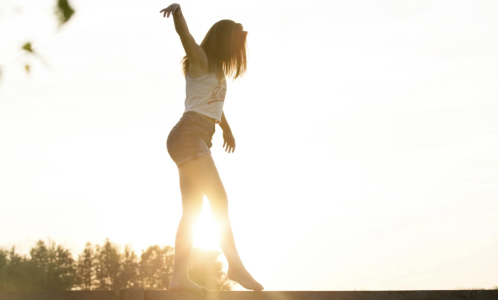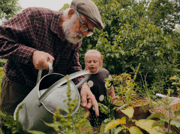Over 55? These 4 simple balance tests may reveal you're aging in reverse
By
Veronica E.
- Replies 0
Disclaimer: The information provided in this article is for educational purposes only and is not intended as a substitute for professional medical advice, diagnosis, or treatment. Always consult your physician or other qualified healthcare providers with any questions you may have regarding a medical condition or before making any changes to your health regimen.
Getting older is inevitable, but how you feel as you age?
That’s something you can influence—especially when it comes to balance.
While many people focus on strength or endurance, research shows that balance may be one of the clearest indicators of your overall health and even longevity.
And the good news? You don’t need fancy equipment or a gym membership to assess it.
With just a few simple tests, you can get a surprising snapshot of how well your body is aging—and even catch small issues before they become big ones.

Balance isn’t just about preventing falls (though that’s important).
It reflects how well your muscles, joints, brain, and inner ear are working together—often before other issues show up.
Maintaining good balance means your body’s coordination systems are still sharp and responsive, which supports everything from walking and gardening to dancing or playing with grandkids.
In one 2022 study of over 1,700 adults aged 51 to 75, participants who couldn’t stand on one leg for 10 seconds had an 84% higher risk of dying within seven years—even after factoring in age and health conditions.
That finding has sparked new interest in balance as a silent but powerful predictor of healthy aging.
Before you start, find a safe spot near a wall, countertop, or sturdy chair.
No one gets a perfect score the first time, and that’s okay.
These tests are as much about learning where you are as they are about moving toward where you want to be.
This classic test challenges your ankle, hip, and core strength, as well as coordination and reflexes.
How to do it:
Score yourself:
This movement simulates real-life scenarios like walking on uneven surfaces or tight spaces.
How to do it:
Score yourself:
This functional strength test checks whether your legs and core can support your everyday mobility.
How to do it:
Score yourself:
This one removes visual cues, letting your inner ear and muscle memory do the work.
How to do it:
Score yourself:
If you aced all four tests, you’re not just aging well—you might be aging in reverse.
But if you found some of the exercises tough, that’s okay.
These aren’t just assessments—they’re goals. And balance improves quickly with a little consistent effort.
Why is this important? Because balance helps keep you independent, steady, and safe. It can prevent falls (the leading cause of injury in older adults), support brain health, and make everyday tasks easier—from stepping off curbs to climbing stairs.
Research even suggests that balance training improves memory and focus.
Here are some practical ways to improve your stability and confidence, starting today:
Whether you’re starting today or have been working on balance for years, know this: your effort matters.
It’s never too late to grow stronger, steadier, and more confident in your own body.
Read next:

Have any of these balance tests surprised you? Which one felt easiest—or most challenging? At The GrayVine, we believe in building strength together, one small win at a time.
Share your thoughts, tips, or balance routines in the comments below—we’d love to hear how you’re keeping steady and staying young at heart.
Getting older is inevitable, but how you feel as you age?
That’s something you can influence—especially when it comes to balance.
While many people focus on strength or endurance, research shows that balance may be one of the clearest indicators of your overall health and even longevity.
And the good news? You don’t need fancy equipment or a gym membership to assess it.
With just a few simple tests, you can get a surprising snapshot of how well your body is aging—and even catch small issues before they become big ones.

Simple balance tests like the single-leg stand can reveal a lot about your health as you age. Image Source: Pexels / Sebastian Voortman.
Why balance matters more than you think
Balance isn’t just about preventing falls (though that’s important).
It reflects how well your muscles, joints, brain, and inner ear are working together—often before other issues show up.
Maintaining good balance means your body’s coordination systems are still sharp and responsive, which supports everything from walking and gardening to dancing or playing with grandkids.
In one 2022 study of over 1,700 adults aged 51 to 75, participants who couldn’t stand on one leg for 10 seconds had an 84% higher risk of dying within seven years—even after factoring in age and health conditions.
That finding has sparked new interest in balance as a silent but powerful predictor of healthy aging.
Also read: Simple chair exercises every older adult can do to improve balance and strength at home
Try these 4 balance tests at home
Before you start, find a safe spot near a wall, countertop, or sturdy chair.
No one gets a perfect score the first time, and that’s okay.
These tests are as much about learning where you are as they are about moving toward where you want to be.
1. Single-leg stand
This classic test challenges your ankle, hip, and core strength, as well as coordination and reflexes.
How to do it:
- Stand tall with your feet hip-width apart.
- Shift your weight to one leg.
- Lift the other foot a few inches off the ground.
- Hold your balance, keeping your eyes forward.
- Repeat on the opposite leg.
Score yourself:
- Excellent: 30+ seconds per leg without touching down
- Good: 15–29 seconds
- Needs work: Less than 15 seconds or frequent wobbling
Also read: How long will you live? Take this surprising test to find out, according to science
2. Heel-to-toe walk (tightrope test)
This movement simulates real-life scenarios like walking on uneven surfaces or tight spaces.
How to do it:
- Stand with your feet together.
- Step forward, placing your heel directly in front of your opposite toe.
- Continue for 10 straight steps, keeping your arms relaxed and eyes forward.
Score yourself:
- Excellent: 10 clean steps
- Good: 7–9 steps with minor wobbles
- Needs work: Fewer than 7 steps or frequent sidesteps
Also read: Are you doing these life-saving exercises to prevent dangerous falls?
3. Sit-to-stand (no hands)
This functional strength test checks whether your legs and core can support your everyday mobility.
How to do it:
- Sit in a sturdy chair with your feet flat.
- Cross your arms over your chest.
- Lean forward and stand up—without using your hands.
- Lower back down with control.
- Try five times.
Score yourself:
- Excellent: 5 smooth reps with no hand support
- Good: 3–4 solid reps
- Needs work: Fewer than 3 reps or relying on your hands
Also read: Older adults face hidden risks from concussions more often than you think
4. Tandem stance with eyes closed
This one removes visual cues, letting your inner ear and muscle memory do the work.
How to do it:
- Stand with one foot directly in front of the other, heel to toe.
- Cross your arms over your chest.
- Close your eyes and hold your position.
- Switch feet and repeat.
Score yourself:
- Excellent: 20+ seconds per side without stepping out
- Good: 10–19 seconds
- Needs work: Less than 10 seconds or stepping frequently
Also read: 11 Simple diet tweaks that might make you feel better
What your results say about your health
If you aced all four tests, you’re not just aging well—you might be aging in reverse.
But if you found some of the exercises tough, that’s okay.
These aren’t just assessments—they’re goals. And balance improves quickly with a little consistent effort.
Why is this important? Because balance helps keep you independent, steady, and safe. It can prevent falls (the leading cause of injury in older adults), support brain health, and make everyday tasks easier—from stepping off curbs to climbing stairs.
Research even suggests that balance training improves memory and focus.
Also read: Find out your real biological age with this simple balancing test—Are you aging too fast
How to build better balance every day
Here are some practical ways to improve your stability and confidence, starting today:
- Stand on one leg while brushing your teeth or cooking
- Practice lunges, step-ups, or side steps during TV commercials
- Try core exercises like planks, twists, or gentle yoga
- Dance in the kitchen, play hopscotch with the grandkids, or join a tai chi class
- Use support at first, like a wall or chair, until you feel steady
- Be consistent—even 5 minutes a day can make a noticeable difference
Also read: Are these strange sensory changes a clue to Dementia? Experts say you shouldn’t ignore them
Make it fun: everyday activities that improve balance
- Join a local tai chi or beginner yoga class
- Take short balance walks by walking along curbs or painted lines
- Play games that involve hopping or balancing with family
- Dance to your favorite tunes—no choreography needed!
Whether you’re starting today or have been working on balance for years, know this: your effort matters.
It’s never too late to grow stronger, steadier, and more confident in your own body.
Read next:
- Reverse aging now: Discover the exercises that defy the common physical decline!
- Rise and shine! 4 morning rituals for balanced cortisol and better health
- What your waistline might reveal about your future health
Key Takeaways
- Balance is a powerful indicator of health for adults over 55 and is closely tied to mobility, independence, and fall prevention.
- Four simple tests—the single-leg stand, heel-to-toe walk, sit-to-stand without hands, and tandem stance with eyes closed—can assess your current balance and identify areas for improvement.
- Studies show that poor balance is linked to significantly higher mortality risk, while regular balance training can improve brain health, stability, and physical function.
- Simple daily habits—like standing on one leg, core exercises, and dancing—can quickly improve your balance and quality of life.
Have any of these balance tests surprised you? Which one felt easiest—or most challenging? At The GrayVine, we believe in building strength together, one small win at a time.
Share your thoughts, tips, or balance routines in the comments below—we’d love to hear how you’re keeping steady and staying young at heart.






